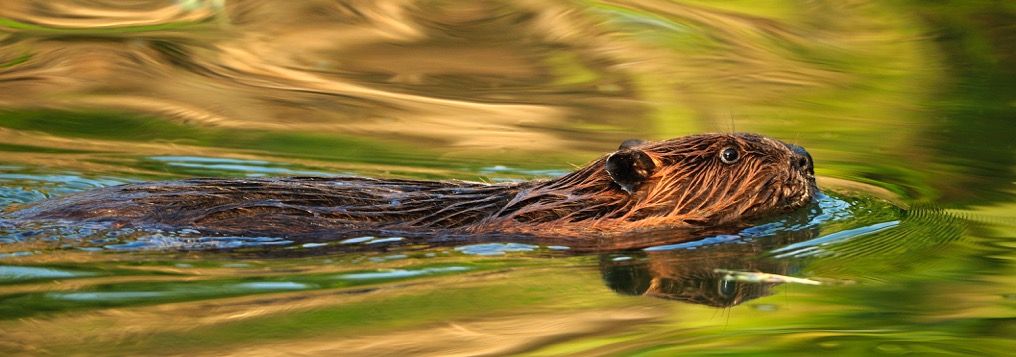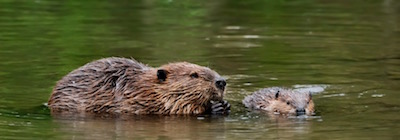Vol. 22 Issue 1, Spring 2017

North American Beaver
Photo by Carson and Jim Clark
By Sharon Plummer
Not many mammals have a National and International Day named in their honor, but beavers (Castor canadensis) hold that trophy, due to their amazing adaptations, exceptional engineering skills and their immense impact on our landscape.
The tools they posses include translucent eyelids to see underwater and self-sharpening, razor-edged teeth that never stop growing. Their teeth are reinforced with iron, giving them an orange tone. Those teeth can cut down a small tree in a matter of minutes. Their sleek flat tail serves as a rudder to skillfully steer them through the waters to build dams across streams and rivers. Their webbed feet give them the power to swim and easily construct complex lodges on or beside the ponds they have created.

Beaver with offspring
Photo by Carson and Jim Clark
With all of these assets, you can see why they can play such an important role in our ecosystem for both humans and other creatures. The ponds they create become a fountain of life, with insects, fish, amphibians all bubbling with activity, alongside deer, fox and waterfowl, which will now come to this watering hole.
Beaver dams reduce the impact of flash flooding because they hold back the debris and sediment, helping preserve the floodplain. They build lodges on or beside their ponds out of sticks and mud. They will raise their family in these lodges that have two rooms, one “mudroom” for drying out and then the main den. Beavers are in the rodent family, with sizes averaging from 30 to 70 lbs. because they never stop growing. They mate for life and can live up to about 29 years in the wild. Many people think that beavers eat fish, but they are strict herbivores, preferring the bark of birch, cherry, and maple trees, as well as water lilies and other aquatic plants.
Beavers are believed to inhabit almost every county in Virginia. In Loudoun County, you can search for them at the Dulles Wetlands or Banshee Reeks, though they do most of their busy work at night. We are so lucky to still have these unique and talented creatures among us contributing to our ever-evolving landscape.
Resources:
loudounwildlife.org/1998/04/beavers-making-slow-comeback/
www.sciencekids.co.nz/sciencefacts/animals/beaver.html
www.dgif.virginia.gov/wildlife/nuisance/beaver/

